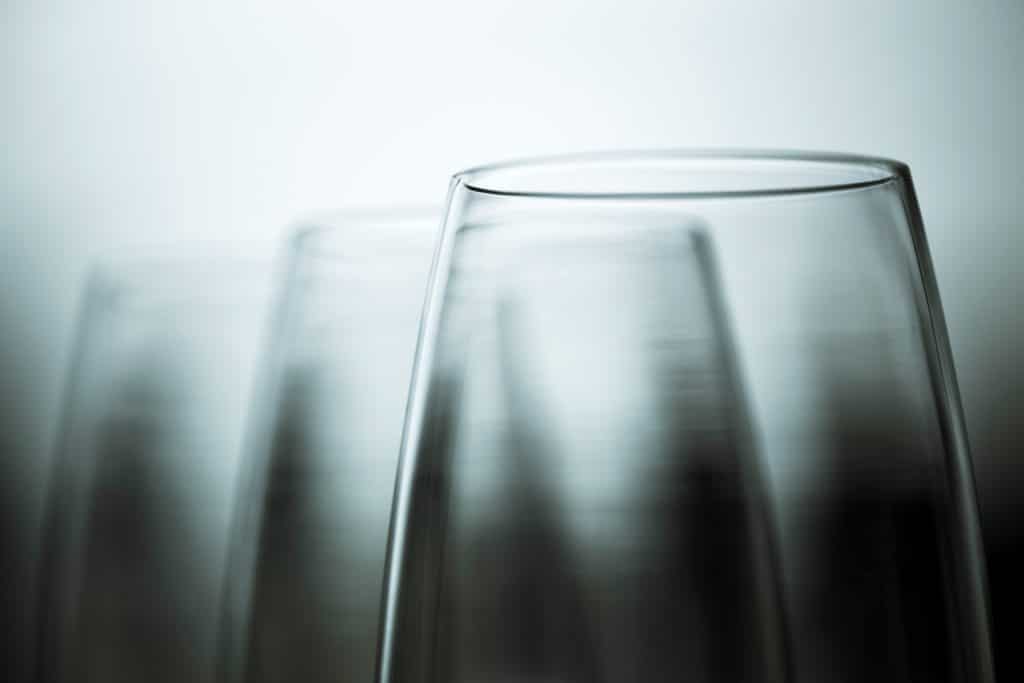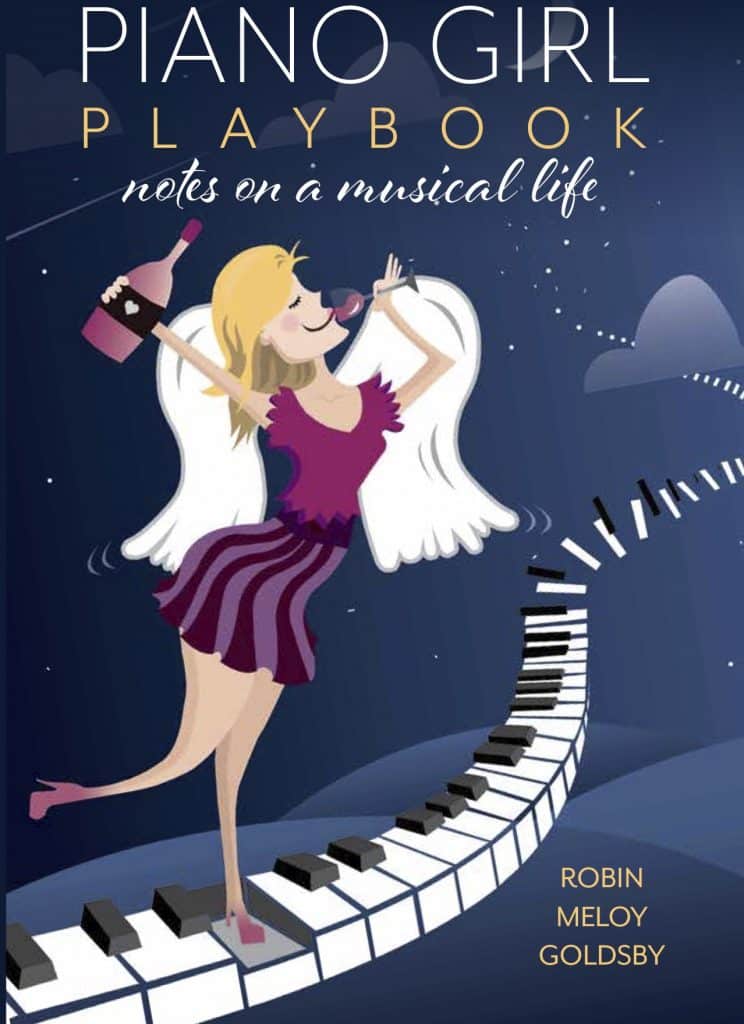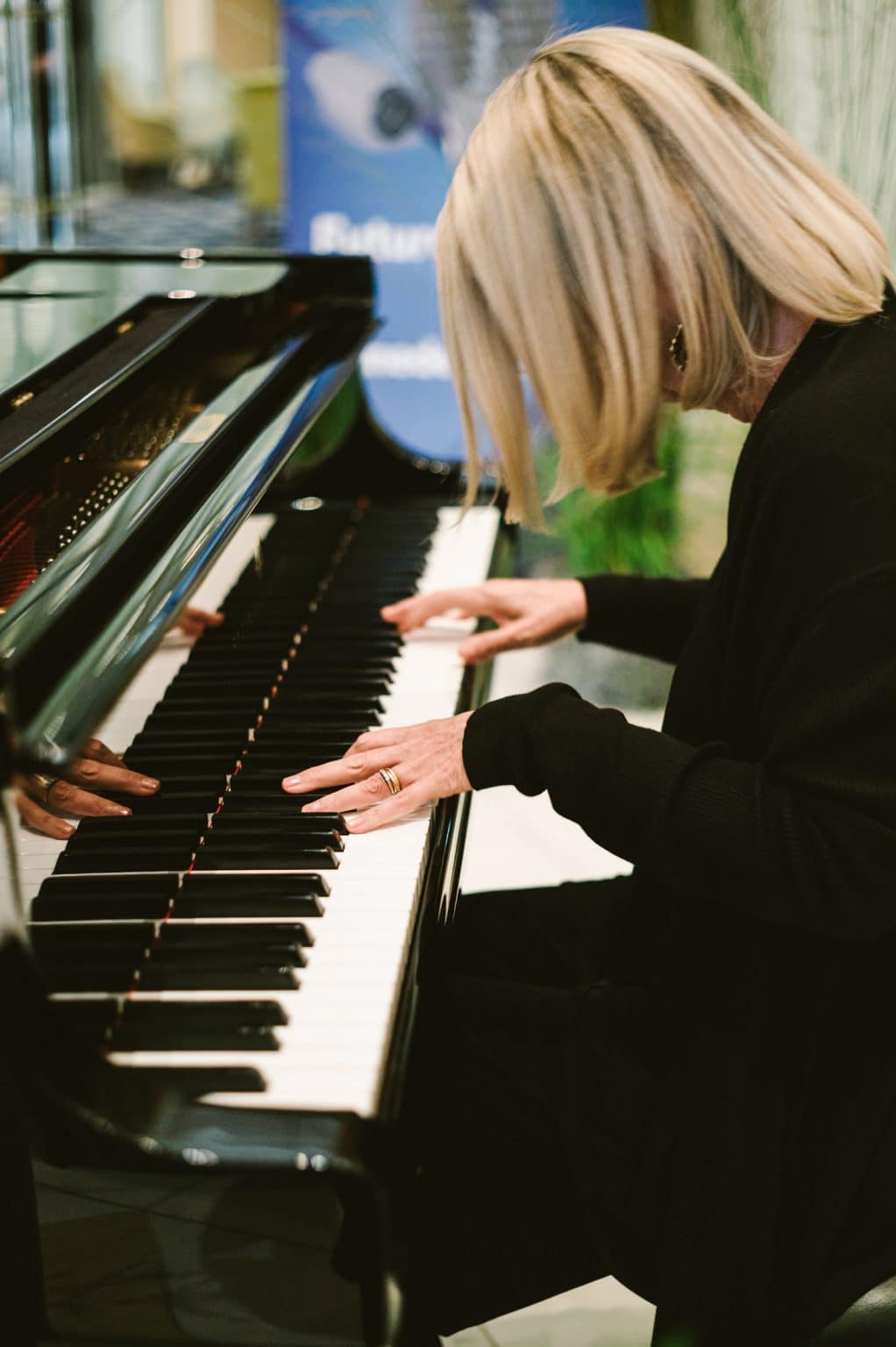
I stopped drinking a year ago. Those of you familiar with my tales of debauchery and hijinks from the piano lounge might find it hard to believe that I could soldier through a five-hour solo piano gig without a glass of Sancerre on the little marble table next to the Steinway. But here we are—Piano Girl 2.0, steady and secure in my newfound sobriety. Hold the sauvignon blanc. Pass the lemongrass-infused green tea, please. Shoot me now.
Every evening when six o’clock rolls around and I’m sipping ginger-ale, I wonder if I’ve made the right call. What fun is this? If I’m at work, I’m heading into my last set of music. If I’m home, I’m thinking about dinner prep. Both activities—transitions from one part of the day to another—have historically (or hysterically) been cocktail triggers for me. Wow, my brain says—time to soften my focus and loosen things up a bit. Nothing wrong with this plan, in principle. Soft focus is good. No focus, not so much. As I’ve gotten older, I’ve realized I need my wits about me to make sense of things that used to be second nature—playing the piano without sounding like an idiot, for instance. Or writing. Or dicing fresh ginger into impossibly small pieces. Or getting through the evening without bursting into tears at least twice.
Why did I quit? Two years ago, my husband, John, was diagnosed with metastatic breast cancer. Nutrition became a big part of his recovery plan. No more alcohol. Alcohol turns to sugar and cancer loves sugar. John had stopped drinking a few months before he received his diagnosis, almost as if his body knew there was trouble down the pike. It took me a year of drinking/not drinking to get onboard, but the self-discipline sobriety ship has sailed and I’m content to be a passenger, even if I’m slightly bewildered about where the damn ship is heading. But at least, I’m focused.
Following the onset of the cancer crisis, we, like all of you, experienced the paralyzing shock of Pandemic: Season One. I decided I would strive to come out of the lockdown healthier than I was before it started. This meant staying away from the potato-chip couch and finally bailing on the booze. I was never a mean drunk, a happy drunk, or a fall-down black-out drunk—I was more of a sleepy drinker. I could easily knock back half a bottle of good wine every evening before falling into a grape-induced fitful slumber. I was one of those women who, when asked by a doctor if I drank, routinely responded: “Oh, not really, just a glass of wine with dinner once or twice a week.”
Doctors, listen up! The “one glass with dinner” lie has been propagated for so long by so many that it’s widely accepted as truth. I don’t know a single drinking person who only has one four-ounce glass of wine with her meal once or twice a week. And if you want the two-glass buzz, forget drinking with dinner. You need to drink before you eat. Six o’clock always worked for me.
I remember my two grandmothers showing up one New Year’s Eve to babysit for my sister, brother, and me so my mom could go to my dad’s gig at a Pittsburgh nightclub. Mom told both grandmothers they could each have one drink. After she left, Della and Laura slinked into the kitchen and found the biggest glass receptacles in the overhead cabinets—a flower vase and an ice bucket—and made their cocktails following my mother’s “just one” instructions. In their defense, my sister and I had prepared a two-hour Sammy Davis, Jr. lip-syncing extravaganza for them, so I’m sure they required sustenance.
Over the years, I’ve worked alongside award-winning sommeliers in Europe’s best houses, playing piano for people willing to pay a king’s ransom for a simple bottle of wine. In former times, some of that elixir—sent to the piano by a generous guest—would be my beverage of choice for the evening. Surrounded by shadowy elegance, flickering candlelight, and eccentric service staff who occasionally tossed rose petals on the piano, how could I resist a glass or two of overpriced swill?
One of my favorite sommeliers, a lovely man named Silvio Nitzsche, once told me that the enjoyment of wine depended less on the wine’s quality and more on ambience and company—that the key to savoring a bottle of the good stuff is to drink it in a beautiful place with someone you love. I’m now hoping that same philosophy applies to sparkling water with lime.
Here’s a story: On one of my private party piano gigs in a German castle, a gold-toothed corpulent client—complete with a Versace-clad supermodel hanging from his arm—decided he liked my rendition of “Let It Be.”
He boomed: “You play ‘Leet Eeet Bee.’”
This man was used to getting what he wanted. I’ve never responded well to rudeness and my trained-seal days are well behind me, but he also slapped a hundred euros on the piano. So I smiled and played the tune, the Piano Girl equivalent of balancing a ball on one’s nose. The “Leet Eet Bee” request happened five more times, each time accompanied by dwindling amounts of cash. Eventually, the guests left for dinner in a room attached to the main hall. My gig was over. The sommelier ran to the piano with a glass of viscous red wine and said, “This is from the guy with the gold teeth. He wants to hear “Let It Be.’”
“Again?”
“Again.”
“Forget it,” I say. I already played it six times and I’m finished for the evening. I like Paul McCartney as much as the next boomer, but enough is enough.”
“No, no, no,” said the sommelier. “This wine! It’s eighteen hundred euros for a bottle. He sent it as a gift. ‘Leet Eet Bee.’ You have to play eet and drink eet.”
I drank the wine, even though I had already inhaled two lesser glasses of white wine that someone else had sent to the piano. Being a wine idiot, I did not recognize the greatness of this blood-colored, slightly smoky wine. I could always distinguish the difference between bad and good wine, but the disparity between good and great escaped me. I was also terrible with remembering the names of wines I had enjoyed over the years, perhaps due to that soft focus issue I mentioned earlier. By the time I decided I liked a particular wine, I was too far in the bag to commit its name to memory. I don’t think this is mentioned in the average twelve-step program, but I suspect that an inability to recall what one is drinking might be an early warning sign that one should not be drinking so much.
At this point in my adventure with the stout McCartney fan, I had consumed more money in wine than my salary for the entire weekend, a financial slap in the face for any musician, especially one with college bound children.
How can I leave all these fond memories behind, you might ask? I’m not sure if alcohol is really such an integral part of our fun-loving adult lives or if we’ve all been brainwashed to believe that it’s impossible to have a good time (or a bad time) without it.
Here’s a typical scene from almost any current television program—a coatless, borderline-anorexic woman busts through her luxury high-rise apartment door, beelines to the fridge, grabs an open bottle of wine and pours it into a glass that might as well be a bucket (Della and Laura would approve). She kicks off her Jimmy Choos, then walks around her bookless home—decorated in shades of taupe—and cries, laughs, craughs. It almost doesn’t matter, because she has her wine.
The drinking culture is everywhere. At tacky weddings and big deal birthdays and lovely christenings and tearful funerals. At rowdy athletic events and classical concerts and high-school graduations. If we’re not being offered a cocktail, a glass of Prosecco, a beer, or an Aperol Spritz, we’re seeing ads for booze or sexy scenes in films that involve cut glass tumblers and bottomless bottles of Scotch.
We meet each other for drinks, toast our friends, and reminisce about the time–forty years ago—when Susie (perhaps not her real name), had too many tequila shots, stripped to her knickers, did the alligator dance on the bar, and boffed the bartender after last call. How funny was that? Or how about the time she got so drunk she mistook the candleholder for a wine glass and burned her nose with scalding wax when she attempted to drink from it?
That Susie, what a party girl.
I used to think that alcohol defined my life. I’m writing about it, so I guess, in some ways, it still does. Even in an essay about giving up alcohol, here I am making my drinking life sound funny and glamorous. It was, sometimes. Is there anything more hopeful than a martini glass holding the promise of the evening ahead? The sensory accessories that accompany the consumption of alcohol are almost as seductive as the alcohol itself—the fluted shape of a crystal glass, the floral perfume of an artisanal gin, the fragile stem of the glass between your pulsing fingers, the rhythm of the cocktail shaker, the ice-cold slice of silver as the vodka slides down your throat. And don’t get me started on olives.
The truth? I didn’t feel good when I was drinking. That simple.
A life after sixty is one of sacrifice, but not without rewards. I’ve given up smoking and dairy and meat and wheat and I’m healthier as a result. I’ve given up inappropriate men and toxic relationships and gained a beautiful marriage and a circle of loyal friends for whom I would die. I’ve watched my kids amble away from home but have reaped the rewards of their steadfast devotion to their father and me. Sacrificing things I thought I couldn’t live without has paid off in unexpected ways.
I assumed the world would be boring without booze. But serenity, it turns out, is not my enemy. I try to meditate, I treasure the lack of drama in my life, I wander—still bewildered but clearheaded—through the chaos of midlife knowing I’m at peace with myself. I miss the idea of “Susie,” but not enough to revisit her memory in real time.
These days I pull myself together at six o’clock, pour some Pellegrino into a festive wine glass, add some lemons, or if I’m in an exotic mood, a berry or two, and toast my husband knowing that I’ll sleep well and awaken feeling even-tempered, rested, and possibly a little boring.
I’m almost sixty-four. Boring is so much better than it’s cracked up to be.
A wellness preacher, I am not—I’m not suggesting that anyone else stop drinking. My career as a cocktail pianist depends on people’s willingness to show up, sip something delicious, and be transported to another plane by music and beverage. I realize that substituting Kombucha for vodka at cocktail hour requires mental gymnastics; I also realize that there are millions of mid-life women just like me, who don’t necessarily need a detox trip to Betty Ford, but might benefit from an attitude readjustment. Those of us in the addict-lite category only need to step away from the corkscrew long enough to realize that life can be pretty wonderful without wine, especially once the fog clears.
Serendipitous timing! Just as I was giving up alcohol, I had a cocktail named after me—a pretty big achievement for someone who has been playing in cocktail lounges for forty-five years. The drink, called “The Goldsby,” involves Ruinart Champagne, peach brandy, bitters, and a sprinkling of edible gold dust. Bam! It’s served at Excelsior Hotel Ernst—the hotel where I play the piano—in a retro bowl-shaped crystal Champagne coupe. It’s the prettiest thing I’ve ever seen and even though I’m not tempted to drink one, I’m thinking about ordering the Goldsby just so I can sit on the chic leather banquette at the hotel and balance it in my hand. I do so love a good prop.
“Maybe the barman can concoct a virgin Goldsby,” I say to my husband.
“A virgin Goldsby?” says John. “Good luck with that.”
Perhaps an empty glass would do. But I’m not giving up the gold dust.
***
Robin Meloy Goldsby is a Steinway Artist and popular solo piano streaming artist. She is the author of Piano Girl; Waltz of the Asparagus People: The Further Adventures of Piano Girl; Rhythm: A Novel and Manhattan Road Trip, a collection of short stories about (what else?) musicians. New from Backbeat Books: Piano Girl Playbook: Notes on a Musical Life

